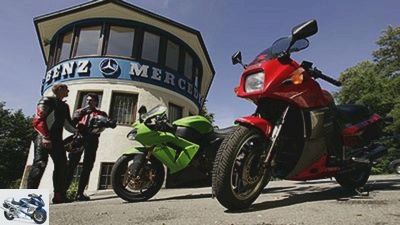Menus

Artist
Comparison between new and old part 2
What is progress?
With knives, progress is quickly explained: higher, faster, further. However, just as important as the performance are things such as suitability for everyday use, passive safety and environmental compatibility. The second part of the new versus old comparisons answers the following questions: Is the water-cooled Yamaha XT 660 R still the same easy-care buddy as the Yamaha XT 600 from 1989? How did the Kawasaki GPZ 900, hyper athlete of the 80s, mutate into a touring athlete compared to the Kawasaki ZX-10R? And: Does the so-called bread-and-butter bike CBF 500 ABS taste better today than the Honda CB 500 back then?
There should actually be some
who brought their XT to a Yamaha authorized workshop for service. Adjust most of the completed valves, change chain sets, oil or tires yourself. Even some major engine damage was repaired on the kitchen table. Almost all XTs lived a packhorse after purchase. Always ready for off- and on-road, long and short trips, they successfully acted as the best mechanical friend one could imagine. 21 percent
In 1989, the Yamaha dealer charged the average annual income for this friendship, exactly 8,035 marks.
Today it is 6603 euros. According to statis-
According to the Federal Office, this corresponds to 23 percent. Our earnings and the cost of living have increased. So do our expectations. But can the packhorse image and trendsetter be combined? Let it be said to those who always complain: Without dampening and cool-
With a single-cylinder water jacket, neither the currently applicable exhaust gas nor noise regulations have to be complied with. So a must. One that, of course, has a negative impact on weight. At 192
The 660 weighs 31 kilograms more than the air-cooled one, which is 15 years younger-
more sister. Not everything is due to the water cooling. The two rear silencers of the new ones alone weigh 5.5 kilograms each, which is almost three times as much as the delicate trumpet of the 600 series. In addition, there are more important components such as brake and footrest system, battery, fork, wheels, swing arm or the frame, for the first time in the XT history in a version with double upper cables.
Does it really have to be that difficult? A small digression: Four-cylinder super sports cars are almost at the same weight level thanks to the use of high-strength, lightweight materials and sophisticated manufacturing techniques. A Yamaha R1 shows off 172 HP liter output at 203 kilograms. Each horsepower accelerates 1.18 kilograms. The 1989 supersport highlight, the 135 hp FZR 1000 Exup, weighs 236 kilograms ?? makes 1.74 kilograms per horsepower. Progress in readings. Back to the XTs: The 600 series has an output of 75 PS per liter, the new one only has around 73. Each PS of the 660 R tugs at 3.84 kilograms. The old 600, on the other hand, is »only« 3.57 kilograms. So where is the progress here??
It can be experienced in the literal sense. Water cooling, injection, three more horsepower ?? two sisters become strangers. While the old one tenaciously and phlegmatically distributes power and torque over the speed range, the new one hangs spontaneously on the gas. Doesn’t swallow or chop even if you open the throttle valve on the single ad hoc. And consumes 3.9 liters per 100 kilometers even half a liter less. When switching from
the 600 to the 660, two feelings arise. First: at least ten more horsepower. Second: The crankshaft and pistons do not seem to act in the oil, but in a mass of gummy bears. Any-
how muffled. Rubbery. Soft. Still robust. The only drawback of the new one
Drive: constant travel jerking in the partial load range. Yamaha promises improvement.
Okay, the 660’s engine is better than the 600’s in all respects. And as long as the two sisters on the
The new one not only has romp on the street
ahead when accelerating. you
brakes better: double-piston floating caliper. Or steers more precisely: the Fahr-
factory coordination was quite tight. And shifts with incredible ease. Off-
road, on the other hand, turns the tide. This is where the 600 shines. The narrower tank-bench combination makes gymnastics easier. In addition, there is the weight advantage. In addition, the suspension travel is around three centimeters longer, the turning circle is exactly 3.5 centimeters smaller at 4.15 meters, the driver’s footrests are six centimeters higher, and the 600 has around ten centimeters more ground clearance than the 660 at 25.5 centimeters.
But Aachen is not Africa. The
The new one masters most legal gravel roads just as easily. What remains is that
XT myth. Mechanical buddy. Pack mob. And although the 660 R through
her lines are trendy, she will
does justice to the XT image of the all-rounder. Sweaty kicking or choke-
fumbling are passe ?? Progress through greater suitability for everyday use. All screwdrivers should be told: Do-it-yourself is a bit more complex due to the water cooling, but still problem-free (see table on page 47). Workshop visitors can also sleep with peace of mind: the new one has longer inspection intervals and shorter reference times. Last but not least, two messages to the technicians responsible: Please attend a cooling hose installation course and don’t skimp on the details. The new one is with
made much less love than
the old. After all, the eye goes with it.
Buy complete article

Comparison between new and old part 2
What is progress?
Technical data: Yamaha XT 600
M engine: water-cooled single cylinder-
Four-stroke engine, four valves, injection,
Ø 44 mm, U-Kat with SLS, mechanical
actuated multi-plate oil bath clutch, five-speed gearbox, O-ring chain. drilling
x stroke 100 x 84 mm, displacement 660 cm3, rated power 35.3 kW (48 PS) at 6000 rpm, max. Torque 58 Nm
at 5250 rpm. M chassis: single-loop steel frame, telescopic fork, Ø 43 mm, two-arm swing arm with central spring strut, disc brake f / r, Ø 298/245 mm. Tires 90/90 21; 130/80 17.
M Dimensions and weights: wheelbase 1505 mm, steering head angle 62.75 degrees, according to-
barrel 107 mm, suspension travel f / h 225/200 mm, seat height * 850 mm, weight with a full tank ** 192 kg, payload * 178 kg.
Price test motorcycle ** 6603 euros.
Technical data: Yamaha XT 660 R
M engine: air-cooled single-cylinder four-stroke engine, four valves, register carburetor, Ø 28 mm, kick starter, mechanical
actuated multi-plate oil bath clutch, five-speed gearbox, O-ring chain. Bore x stroke 95 x 84 mm, displacement 595 cm3, rated power 33 kW (45 PS) at 6500 rpm, max. Torque 50 Nm at 5500 rpm. M chassis: single loop-
Window frame made of steel, telescopic fork, Ø 41 mm, two-arm swing arm with central spring strut, disc brake f / r, Ø 270/220 mm. Tire 3.00 S 21; 4.60 S 18.
M Dimensions and weights: wheelbase 1435 mm, steering head angle 62 degrees, according to-
barrel 109 mm, suspension travel f / h 255/235 mm, seat height * 910 mm, weight with a full tank * 161 kg, payload 194 kg.
Price (1989): 8,035 marks.
Conclusion
The XT through the ages. It has become friendlier, more suitable for everyday use, more stable and more efficient.
But also heavier and less
off-road and pillion compatible ?? the thin bench is a cheeky joke. The most important thing, however, has been retained by the XT. Her charm as an easy-care, reliable, rough leg and the notorious spread of lust for speeding through
any radii. This is precisely what succeeds unlike the 660 with the more power and the stiffer chassis
quicker than with the older sister.
What is progress?
With measured values, progress is quickly explained: higher, faster, further. As important as
however, the performance are things like suitability for everyday use, passive safety or environmental compatibility. The second part of the new versus old comparisons answers the following questions: Is
the water-cooled XT 660 R still the easy-care companion for stealing horses? How did the GPZ 900 R, hyper athlete of the 80s, mutate into a touring athlete from today’s perspective? And: Does the so-called bread-and-butter bike taste better today than it did back then? Culinary guests: Honda’s mid-range two-cylinder.
Related articles
-
Photos: fact Concept comparison 100 HP 100 HP – The whole truth In the past, material for endless discussions: 100 HP. Today completely normal ?? but not less…
-
Comparison test beginners State of the art Inexpensive, functional, even reasonable: In the past, these words provided sales arguments for the GS 500 E and …
-
Comparison test: Honda CX 500-650 Turbo, Kawasaki Z 750 Turbo, Suzuki XN 85, Yamaha XJ 650 Turbo
Jahn 21 pictures Jahn 1/21 The preload of the central spring strut of the Suzuki can be easily adjusted. Jahn 2/21 Tight corners and fast …
-
Comparison test: three travel enduros in comparison
Comparison test: Travel enduros from Ducati, KTM and BMW Three travel enduros in comparison With four different driving modes – Touring, Sport, Urban …
-
Jahn Concept Comparison: Enduros Between Hard Enduro and Motorhome The boundaries between hard enduro and motorhome are blurring more and more. MOTORCYCLE…
-
Comparison test: how much power does a man need?
Gargolov comparison test: Ducati, Kawasaki, KTM, Triumph and Yamaha How much power does a man need? Riding a motorcycle is fun. Make strong motorcycles …
-
Yamaha XSR 700 and Ducati Scrambler retro bikes in comparison
28 pictures Rossen Gargolov 1/28 Twice conversion optics ex works in the lower middle class, two times 75 HP, full beard and …
-
Yamaha Tracer 700 and Kawasaki Ninja 650 in comparison test
Arturo Rivas Yamaha Tracer 700 and Kawasaki Ninja 650 in the comparison test of mid-range sports tourers Some like it upright, others more …
-
Yamaha MT-09 and MV Agusta Brutale 800 in comparison test
bilski-fotografie.de 16 pictures bilski-fotografie.de 1/16 MV Agusta Brutale 800 and Yamaha MT-09. www.bilski-fotografie.de 2/16 Typical MV: Hybrid frame …
-
Comparison test: seven enduro bikes in Sweden
Jahn 28 pictures Jahn 1/28 The operation of the Multistrada has also changed: A control center for electronics and motor directly on the handlebar. Jahn 2/28 …